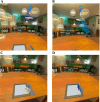The feasibility of virtual reality therapy for upper extremity mobilization during and after intensive care unit admission
- PMID: 39802193
- PMCID: PMC11725268
- DOI: 10.7717/peerj.18461
The feasibility of virtual reality therapy for upper extremity mobilization during and after intensive care unit admission
Abstract
Introduction: Early mobilization reduces long-term muscle weakness after intensive care unit (ICU) admission, but barriers (e.g., anxiety, lack of motivation) may complicate patients' adherence to exercise. Virtual reality (VR) presents immersive stimuli, which may increase motivation and adherence. This study aimed to examine the feasibility of VR-therapy using a VR-headset during ICU- and subsequent general ward admission. Furthermore, physical parameters before and after training were explored.
Materials & methods: Ten adult ICU-patients with a median age of 71 [63-79], 70% of male registered birth sex, mechanically ventilated for ≥48 h, and willing to participate, were included. VR-therapy was offered three times a week for 20 minutes in addition to standard care. To train upper extremity functionality, patients were instructed to complete puzzles with increasing level of difficulty. Feasibility was based on patient satisfaction, session efficiency, and adherence levels during the training. Fatigue was measured after each session using the Borg Rating of Perceived Exertion Scale. Patients' hand-grip strength and Morton Mobility Index (MMI) were evaluated at the start of VR-therapy and after four weeks of training or at hospital discharge.
Results: On average, patients followed three VR-therapy sessions of 20 min per week with 13 min of actual training time, over the course of 1 to 3 weeks depending on their length of stay. Session efficiency ranged from 25% to 93%. In total, patients adhered to 60% of the VR-therapy sessions. MMI scores increased significantly from the start (26 [24-44]) to the end of the VR-therapy training period (57 [41-85], p = 0.005), indicating improved balance and mobility.
Conclusion: VR-therapy for upper extremity rehabilitation in ICU-patients is feasible during stay in the ICU and general ward.
Keywords: Critical illness; Mobilization; Rehabilitation; Virtual reality.
©2025 de Vries et al.
Conflict of interest statement
The research team collaborated with 8D Games for the development of the VR-game. Development costs were covered by a dedicated innovation fund of the Medical Centre Leeuwarden. VR-headsets were acquired by the Intensive Care Unit of the Medical Centre Leeuwarden.
Figures


References
-
- Amirthalingam J, Paidi G, Alshowaikh K, Jayarathna AI, Salibindla DBAMR, Karpinska-Leydier K, Ergin HE. Virtual reality intervention to help improve motor function in patients undergoing rehabilitation for cerebral palsy, Parkinson’s disease, or stroke: a systematic review of randomized controlled trials. Cureus. 2021;13(7):e16763. doi: 10.7759/cureus.16763. - DOI - PMC - PubMed
-
- Azoulay E, Vincent JL, Angus DC, Arabi YM, Brochard L, Brett SJ, Citerio G, Cook DJ, Curtis JR, Dos Santos CC, Ely EW, Hall J, Halpern SD, Hart N, Hopkins RO, Iwashyna TJ, Jaber S, Latronico N, Mehta S, Needham DM, Nelson J, Puntillo K, Quintel M, Rowan K, Rubenfeld G, Van den Berghe G, Van der Hoeven J, Wunsch H, Herridge M. Recovery after critical illness: putting the puzzle together-a consensus of 29. Critical Care. 2017;21(1):1–7. doi: 10.1186/s13054-016-1589-6. - DOI - PMC - PubMed
-
- Baldwin CE, Paratz JD, Bersten AD. Muscle strength assessment in critically ill patients with handheld dynamometry: an investigation of reliability, minimal detectable change, and time to peak force generation. Journal of Critical Care. 2013;28(1):77–86. doi: 10.1016/j.jcrc.2012.03.001. - DOI - PubMed
MeSH terms
LinkOut - more resources
Full Text Sources

